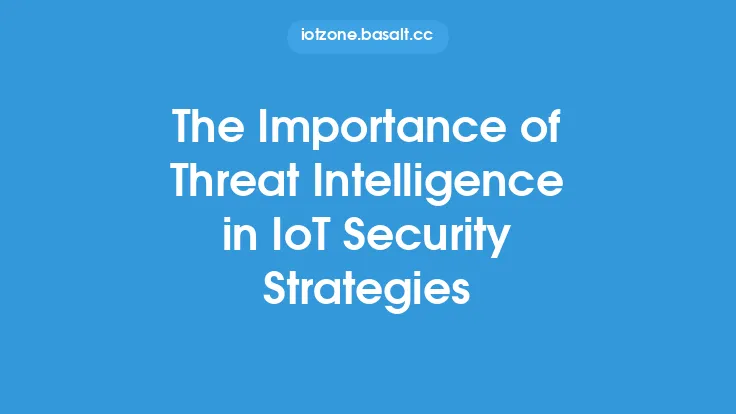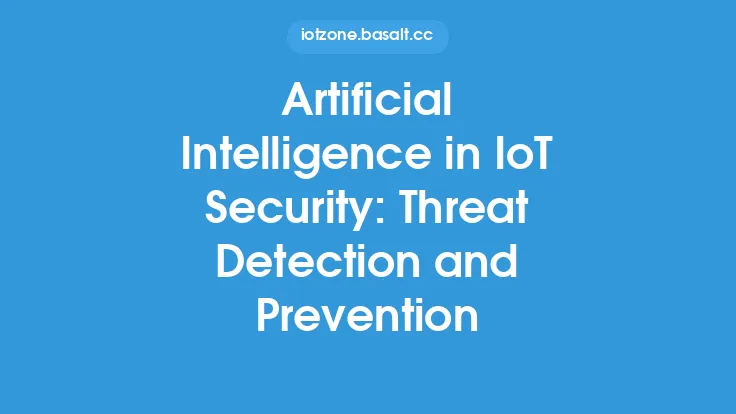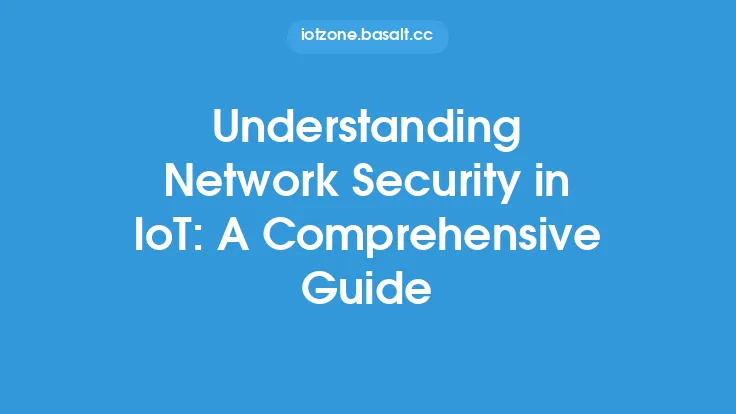The Internet of Things (IoT) has revolutionized the way we live and work, with an ever-increasing number of devices becoming connected to the internet. However, this increased connectivity has also introduced new security risks, making it essential to understand the concept of threat intelligence in IoT security. Threat intelligence refers to the process of gathering, analyzing, and disseminating information about potential or actual security threats to an organization's IoT devices and systems. In this article, we will delve into the world of threat intelligence in IoT security, exploring its importance, types, and applications.
Introduction to Threat Intelligence
Threat intelligence is a critical component of any IoT security strategy, as it enables organizations to stay ahead of emerging threats and vulnerabilities. It involves the collection and analysis of data from various sources, including network traffic, system logs, and threat feeds, to identify potential security risks. This information is then used to inform security decisions, such as updating firewall rules, patching vulnerabilities, and implementing new security controls. Threat intelligence can be categorized into three main types: strategic, tactical, and operational. Strategic threat intelligence focuses on high-level threats and trends, while tactical threat intelligence provides detailed analysis of specific threats and vulnerabilities. Operational threat intelligence, on the other hand, is focused on the day-to-day security operations and incident response.
Types of Threat Intelligence
There are several types of threat intelligence that are relevant to IoT security, including:
- Indicators of Compromise (IoCs): These are pieces of evidence that suggest a security breach has occurred, such as unusual network traffic or suspicious system logs.
- Indicators of Attack (IoAs): These are pieces of evidence that suggest an attack is underway, such as exploit attempts or malware detections.
- Threat Actor Intelligence: This type of intelligence focuses on the individuals or groups behind a threat, including their motivations, tactics, and techniques.
- Vulnerability Intelligence: This type of intelligence focuses on identifying and prioritizing vulnerabilities in IoT devices and systems.
Applications of Threat Intelligence in IoT Security
Threat intelligence has a wide range of applications in IoT security, including:
- Risk Management: Threat intelligence can help organizations identify and prioritize potential security risks, enabling them to make informed decisions about risk mitigation and management.
- Incident Response: Threat intelligence can help organizations respond quickly and effectively to security incidents, minimizing the impact of a breach.
- Vulnerability Management: Threat intelligence can help organizations identify and prioritize vulnerabilities in their IoT devices and systems, enabling them to patch and remediate vulnerabilities before they can be exploited.
- Compliance: Threat intelligence can help organizations demonstrate compliance with regulatory requirements and industry standards, such as GDPR and HIPAA.
Technical Aspects of Threat Intelligence in IoT Security
From a technical perspective, threat intelligence in IoT security involves the use of various tools and techniques to collect, analyze, and disseminate threat data. Some of the key technologies used in threat intelligence include:
- Security Information and Event Management (SIEM) systems: These systems collect and analyze log data from various sources, including network devices, servers, and applications.
- Intrusion Detection Systems (IDS): These systems monitor network traffic for signs of unauthorized access or malicious activity.
- Threat Intelligence Platforms (TIPs): These platforms collect, analyze, and disseminate threat data from various sources, including threat feeds, social media, and dark web sources.
- Machine Learning (ML) and Artificial Intelligence (AI): These technologies can be used to analyze large datasets and identify patterns and anomalies that may indicate a security threat.
Challenges and Limitations of Threat Intelligence in IoT Security
While threat intelligence is a critical component of any IoT security strategy, there are several challenges and limitations that organizations should be aware of. These include:
- Data Quality: Threat intelligence is only as good as the data it is based on, and poor data quality can lead to inaccurate or incomplete threat intelligence.
- Data Volume: The sheer volume of threat data can be overwhelming, making it difficult for organizations to analyze and prioritize threats.
- False Positives: Threat intelligence can generate false positives, which can lead to unnecessary resource expenditure and distraction from real security threats.
- Evasion Techniques: Threat actors can use evasion techniques, such as encryption and obfuscation, to avoid detection and evade threat intelligence.
Best Practices for Implementing Threat Intelligence in IoT Security
To get the most out of threat intelligence in IoT security, organizations should follow best practices, including:
- Implementing a Threat Intelligence Platform: A TIP can help organizations collect, analyze, and disseminate threat data from various sources.
- Integrating Threat Intelligence with Security Controls: Threat intelligence should be integrated with security controls, such as firewalls and intrusion detection systems, to enable automated response to security threats.
- Providing Training and Awareness: Organizations should provide training and awareness to security teams and other stakeholders to ensure that they understand the importance and application of threat intelligence.
- Continuously Monitoring and Evaluating: Threat intelligence should be continuously monitored and evaluated to ensure that it is accurate, complete, and relevant to the organization's IoT security needs.





